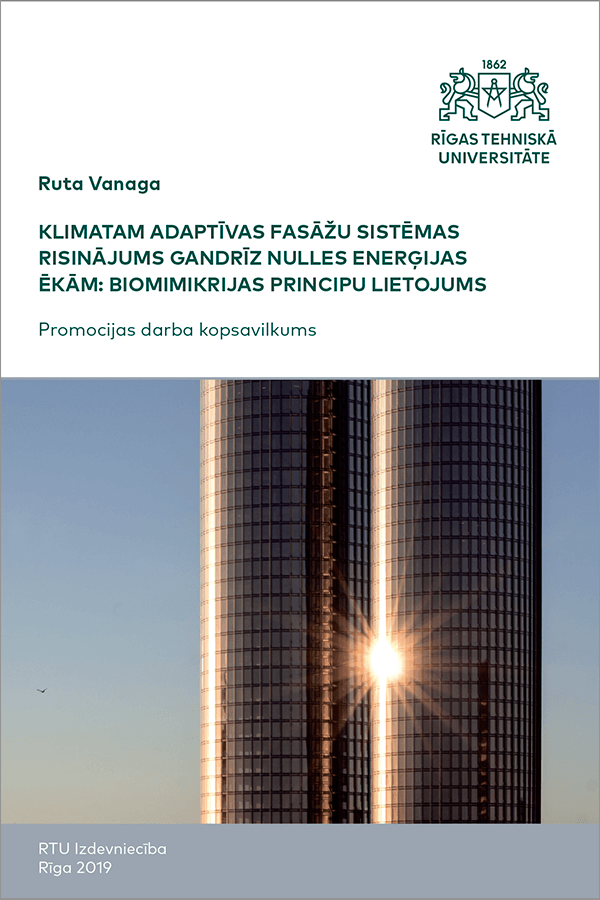Klimatam adaptīvas fasāžu sistēmas risinājums gandrīz nulles enerģijas ēkām: biomimikrijas principu lietojums
Summary of the Doctoral Thesis
Ruta Vanaga, Riga Technical University, Latvia
Doctoral thesis “Climate adaptive building shell: application of biomimicry principles” author Ruta Vanaga is carried out in Riga Technical University, Institute of Energy Systems and Environment. The aim of the doctoral thesis is to develop innovative climate adaptive building thermal envelope that actively contributes providing constant microclimate (temperature) ensuring solar energy storage. To achieve the goal, the following tasks were set: 1. Follow the biomimicry methodology developing the design. 2. Summarize living being’s thermoregulation strategies maintaining constant core temperature. 3. Identify the most suitable thermoregulation strategy to mimic in climate adaptive building shell – solar energy storage wall. 4. Develop concept for climate adaptive building shell – solar energy storage wall. 5. Perform mathematical modeling and simulation for developed CABS concept using COMSOL Multiphysics 5.1. 6. To make a prototype of the developed CABS proposal and to perform an experiment in real climatic conditions. 7. To validate the calculation model with the data obtained in the experiment. 8. To describe the example how to incorporate developed CABS in building design. The thesis includes an introduction and five chapters. The introduction presents the topicality and novelty of the work, defines the aim and tasks of the research, as well as provides information on the methodology and practical use of the research. In the chapter 1, the literature review focuses on low and nearly zero energy buildings. At the begining, the need to design a low and near zero building is proved, technological and functional constraints to achieve the benchmarks set are summarised and it is concluded that there is an urgent need for conceptually new ideas for building envelope constructions. Further on, two innovative directions in the development of new building envelopes – climate-adaptive building shell systems and biomimicry – are described in detail, and examples of objects are described. The chapter 2 describes the elaboration of a proposal for a climate-adaptive building shell module Bi-SES according to biomimicry methodology – starting with the study of nature strategies, the selection of the most appropriate nature strategy with the multi-criteria analysis method and ending with the replication of the chosen strategy in an innovative concept for building envelope that can accumulate and release the solar energy, thus actively participating in the building’s energy balance, increasing the energy flexibility of the building. In the chapter 3 experimental research of climate-adaptive building shell module “Bi-SES” was performed. Two experiments were carried out within the framework of the work. The first experiment determines the most suitable phase change material for the developed design, the second experiment compares the Bi-SES prototype with the reference wall. Detailed description of the experimental set up development and the experiment is described, the scheme of the measurements is shown. The chapter 4 describes the mathematical modeling and model validation of the climate-adaptive building shell module Bi-SES with the data obtained in the experiment. Mathematical modeling was performed in COMSOL Multiphysics 5.1 environment. Model creation, equations used, output data, simulation model validation and modeling results analysis is presented in chapter 4. The fifth chapter describes the integration of the climate-adaptive building shell module “Bi-SES” in a real building.
Additional information
| DOI | |
|---|---|
| Publication type | |
| Hipersaite | |
| Defence date | 11.04.2019. |
| ISBN (print) | 978-9934-22-249-8 |
| ISBN (pdf) | 978-9934-22-250-4 |
| Format | |
| Pages | 47 |
| Published online | |
| Publisher | RTU Press |
| Country of Publication | Latvia |
| Publication language |
You must be logged in to post a review.




Reviews
There are no reviews yet.